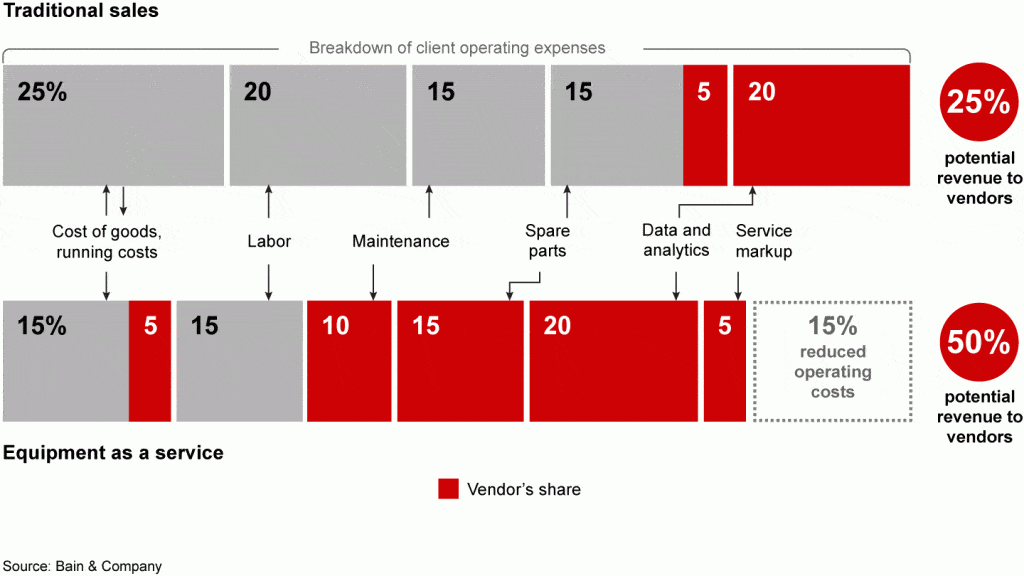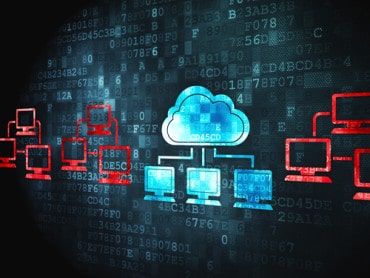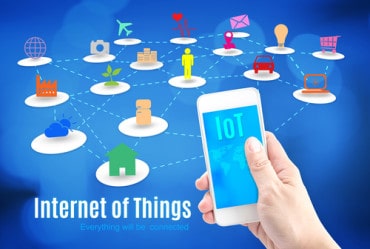
Combined with an intelligent IIoT ecosystem, EaaS can harness the current Industrial Revolution as an opportunity to fuel your company’s growth.
According to the Industrial Internet Consortium: “the first three industrial revolutions were powered by steam, electric energy, and electronics. Today’s Industrial Revolution is powered by data. And that data comes from the “things” that fill your factories and supply chains.”
Even though data-driven decisions enable great improvements, manufacturers today are still faced with multiple and significant challenges:
- Increased competition both with traditional companies and new companies unrelated to your industry, enabled by new technology and innovative solutions
- Customers increasingly want more flexibility and customization, lower costs, and higher quality with shorter time-to-market demands
- Regulations for reducing waste and the emission footprint of your operations
- A workforce without the right skills and mindset needed to move your company forward
As production and supply chain environments evolve, those relying on legacy systems and processes will run into issues in the near and long-term.
See also: Manufacturing is Dead, Long Live ‘Servitization’
Research firm McKinsey lists aftermarket service value and annual services revenue as two vital drivers for success in the industrial sector.
These new subscription and aftermarket revenues from services can be a significant competitive advantage. To enable these, you will need to make cultural and organizational changes, as well as rolling out advanced technologies, like the industrial internet of things (IIoT), predictive analytics, and capture data from assets in the field.
For many, this future will include new business models, like the ability to offer Equipment-as-a-Service (EaaS) or outcome-based contracts.
What is EaaS, and what does it mean for manufacturers?
Also known as servitization, XaaS, or similar, EaaS is a financial model with the added benefit of improving your customers’ operations.
Equipment-as-a-Service is defined as a process in which machinery, equipment or production systems are not purchased, but are provided by a third party for a period in exchange for a fee to use the equipment. In other words, they’re paying per use.
By switching to EaaS, the equipment manufacturer improves its customers’ experiences with less unnecessary maintenance and downtime, while increasing their revenues. EaaS is a try “win-win” scenario with aligned interests of equipment operators, manufacturers, and servicers.
In this model, the EaaS supplier is responsible for any maintenance, service, repairs, or replacements needed throughout the life of the asset — the ability to predict any downtime before it occurs and adapt a maintenance schedule are major elements of this business model. Businesses can also benefit from moving from having the burden of hefty capital expenditures (CAPEX) to more flexible and less costly operational expenditures (OPEX).
While the technology that powers modern EaaS systems is advanced, EaaS is not a new phenomenon.
In 1962 Rolls-Royce trademarked the term ‘power by the hour’ to refer to the notion of selling a turbojet engine on a fixed-cost-per-flying-hour basis. To this today, the company still offers a similar package, now branded Rolls-Royce CorporateCare®, which includes additional features, like engine health monitoring and an extensive network of support centers.
This idea of bundling offerings and accompanying services is another crucial component of EaaS, giving organizations additional touchpoints with customers, as well as opening up new revenue streams while improving operational efficiencies.
Types of EaaS models
Servitization doesn’t mean you’ll have the same contract for every customer. Nor does it mean you’ll implement one kind of arrangement.
Here are some common EaaS examples, as outlined by Deloitte’s “Flexible consumption business models” report:
- Unlimited subscription: This subscription plan allows for an unlimited quantity of your services over a set time.
- Consumption-based: You charge customers on a pay-per-use basis. This model typically doesn’t include a set commitment.
- Predefined subscription: This model gives your customers access to a set number of services over a defined period.
- Outcome-based: In this model, you charge based on the value you deliver to the customer.
- Subscription plus overages: This is a subscription for a predefined amount and a specified period. Any overages are billed based on actual usage.
- Freemium: Customers get access to basic services for free, and you charge a premium for advanced or full features.
The type of model you decide on will be primarily determined by your current business relationships with your customers.
Who wins with EaaS contracts?
Industrial machinery typically involves hefty upfront investments, putting a lot of pressure on equipment providers to reduce their costs.
Yet, when a customer purchases an asset, usually less than a quarter of the total investment is spent on this transaction. The majority of the cost is spent through operating and maintaining the equipment over time.
Regardless of the type of EaaS model used, both equipment manufacturers, as well as operating companies that use their assets, benefit greatly. As demonstrated in the below graphic from Bain & Company, not only do operating costs get reduced, the potential revenue doubles for equipment manufacturers.

Instead of a one-time charge, providers can expand revenue streams through a recurring subscription payment. Meanwhile, operators can avoid huge investments, as well as unpredictable maintenance fees over time, by paying for usage when and where they need it.
Benefits for companies that manufacture equipment
Firstly, equipment manufacturers sell something and then don’t have another interaction with the customer unless there are issues. As a result, aftermarket sales might not be as high as they should be, or customer communications may not be set at a steady, ongoing basis, which is vital for understanding their changing needs and pain points.
On the other hand, with EaaS, manufacturers can have continuous engagement with the customer, allowing for better customer alignment and engagement throughout the relationship.
The second advantage for manufacturers is the predictability of subscription revenues. This model allows for better managed financial risks and stable revenue streams, as well as access to new customer markets.
Thirdly, field service can be performed at lower costs when you switch to EaaS, as you can detect and deploy service technicians and specialists only when it’s needed, such as when a customer places an order or if there is planned maintenance.
This setup leads to more revenue while keeping operating costs down and helping you better align with them.
Other benefits include:
- Custom financing, integrated billing, and other services
- A boost in technically skilled staff attracted by advanced technology (California Manufacturing Technology Consulting reported that smarter factories offer the ability to double or quadruple employment.)
Benefits for companies that operate assets
EaaS models are attractive to operators for a variety of reasons. Ongoing costs for maintenance and operating a machine are decreased, and service costs are bundled into a monthly expense. In many cases, machine uptime is guaranteed. In fact, the aforementioned Bain & Company example cites a 15% reduction in the cost of operating equipment.
In addition to lowering the financial entry point for industrial equipment, such as production systems, machines, and equipment, the operational risk is also transferred to the manufacturer, as opposed to the customer absorbing upfront costs.
With a “pay per use” model, your costs are aligned with your usage, which is more attractive than a fixed monthly fee. Operators can shift from capital expenditure (CAPEX) to operational expenditures (OPEX). This shift can lead to benefits for taxes, support infrastructure, and the machine’s lifecycle. More importantly, since EaaS covers the maintenance and service of assets, your operations will become more efficient compared to traditional processes, which include procurement, installation, testing, validation, and servicing.
Ensuring a successful transformation
What might be holding you back
Implementing technology and shifting revenue models can bring a new set of challenges for some organizations. Whether it’s a lack of expertise or skilled talent to manage the new model or analyze incoming data, retrofitting legacy machinery and overcoming old workflows, or concerns around potentially large upfront investment involved, all of these are common pain points most companies face.
How to overcome common challenges
Equipment-as-a-Service revenue models require time spent in the upfront to identify the right goals before jumping in, ensuring your resources are aligned, and you have a trusted partner to help you through this journey.
The following are vital elements you should have in place before moving forward with EaaS.
Gaining internal alignment
Implementing advanced technology to enable servitization isn’t an initiative for your product or technology departments to manage alone. Leadership from every department within your business should come together to ensure logistics and finances, and everything in between is resolved.
Once you have stakeholder alignment, you need to put your desired business outcomes in the context of what is feasible within the next six months, 12 months, and the long-term opportunity.
Remember, you’re going from selling standalone pieces of equipment to selling equipment-as-a-service. It has an impact on everything, and getting everyone on board may take some time.
Do you have the right customers?
It’s essential to identify the types of customers that would be the most open to an EaaS relationship. In my experience, those facing macroeconomic headwinds or competitive pressures, and those looking to be more efficient with the utilization of their assets, are the types of customers primed for switching to EaaS arrangements.
Understanding the risks
A motto I like to use with customers is “slow down before you speed up.” This saying means you need to understand the risks associated with any digital business transformation. Ask yourself: Do you have the right resources and expertise? What sort of investment in technology will you have to make? What kind of data will you uncover? What will happen if I don’t keep pace and remain competitive? One of the key elements of success is getting as smart about the risks as you are the benefits.
Focus on more than the technology
Technology updates are indeed involved in any EaaS model; however, they should all be implemented to achieve your desired business outcomes. Any IIoT solution is customizable to remotely capture data based on your unique scenario.
Therefore, it’s essential first to determine what business results you want when considering an EaaS adoption. Technology is really just an enabler, and when you approach it through the lens of the business outcomes it can deliver, that’s when servitization shows its tremendous value.
Working with a partner
Even if you already have an infrastructure in place, working with a trusted third-party partner that will walk with you along your business transformation journey will be that much more beneficial. Make sure to select a company that understands your business goals, will sit down with you to discover what your business needs to reach those goals, and also someone that will be with you throughout the process.
Getting started
With subscription-based contracts, you or your customers aren’t buying the equipment so much as the uptime, outcome, and results. And it involves a shift in your core business.
Participating in the subscription economy requires a sound strategy and clear blueprint from the beginning. Having this will lead to faster revenue growth and help mitigate financial risks.
For EaaS success, be sure to follow these basic approaches:
- Conduct a risk assessment
- Determine price points specific to your customers based on a realistic analysis of life cycle costs, including any management, admin, and overhead fees
- Establish reasonable contracts taking all of the above into account
- Institute criteria for withdrawal from services
- Assess individual customers systematically before rolling out contracts
Implementing a servitization model will improve your entire value chain. EaaS allows for greater efficiency and productivity at a time when customers are demanding more, and the competitive landscape is fierce. EaaS gives manufacturers and asset operators financial benefits and guaranteed production and activity targets while strengthening their business relationships.
Ultimately, combined with a modern and intelligent IIoT ecosystem, EaaS offers the potential to harness the current Industrial Revolution as an opportunity to fuel your company’s growth.




























